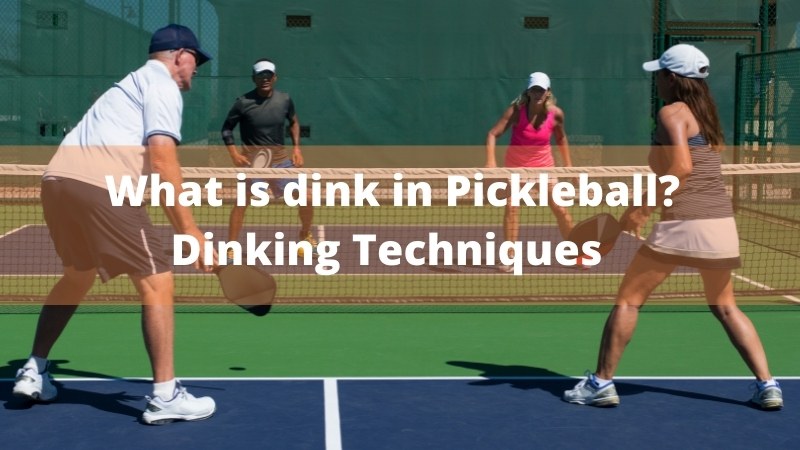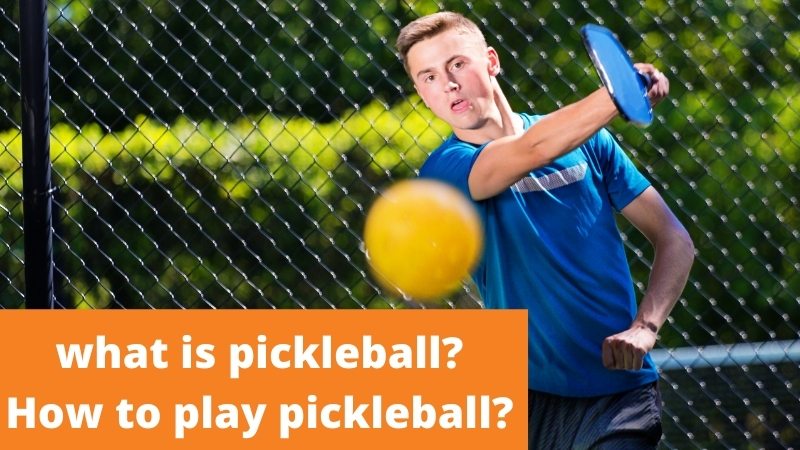
Dinking in pickleball is something you’ve probably heard about. But not sure what it is?
So what is dink in pickleball & pickleball dinking technique? Dink is a well-known shot, known as a softball game among pickleball players.
Here we will elaborate on some important details about dink in pickleball and how you can improve your pickleball dinking technique. You’ll also learn how to play a dink skillfully by reading the basic steps.
What Is Dink in Pickleball?
How you react when your competitor just earned points by hitting a perfect drop shot? What if you respond with a dink shot?
Dinking shot is mainly a softer and higher shot, which usually players hit from the kitchen line or from the non-volley zone.
Ahead of the net, it uplifts and falls speedily. The next shot must be placed high in order for our opponent to return it.
There are two core things for dink shots you will notice.
Ball’s Trajectory
When you play a dink shot, the ball typically goes down or touches the ground speedily. Nevertheless, it is important to take note of the bounce’s peak. The shot is below the net and low down; you need to return the shot by hitting up.
Paddle Angle
While hitting a dink shot, your paddle angle is located up, and the ball is simply lifted and hit over the net.
Why should you play Dink shots?
Most professional players agree that dinking will be the high percentage response when the opponent hits a good drop shot. So the dink shot makes a lot of sense to stay in the point.
In addition to being an excellent option to a well-played drop shot, the dink can also be used as part of an aggressive strategy.
It may sound funny, but it actually looks like chess gameplay. It involves moving the pieces to reveal an opponent’s vulnerability and eventually cause your opponent to get checkmated.
Good dink balls work the same way. The goal is to trick the opposing team into missing the equivalent dink shot. Additionally, the paddle angle is already pointing up, so the ball is already being hit higher than it should be. Alternatively, you will make a shooting gap between your opponent and your shot to earn points.
An excellent tactic to master, dinking can make you a better player. The biggest advantage of dink shots is that it forces a player to play a soft game when he was hitting the ball hard before. You can trick your competitor using this shot, and ultimately he will make a mistake.
Read More:
Paddletek Bantam EX L Pro Review In 2021
Best pickleball shoes for plantar fasciitis (Men and Women)
Paddletek Tempest Wave 2 Paddle Review
5 Practical Pickleball Dinking Techniques
To hit a good dink shot, you must know pickleball dinking techniques. Here are they.
1. Using the Chopper Grip
This grip originated in tennis. The tip of the index finger must be placed exactly on the grip when the hand is positioned in the correct position. It is known as chopper grip because you hold the handle like holding an axe naturally in your hand. You can use this grip to hit low or underhanded balls.
2. Bend Your Knees
With your knees bent, hitting a dink is much easier. A properly hit ball requires you to get under it. Pick up the ball with your knees bent. Legs and calves benefit as well from this exercise.
Maintain your wrists and forearms in a relaxed state and simply use your shoulders to move the paddle.
3. Stroke Consistently
A low underhand stroke is what you need to hit a dink. Once the ball has bounced, it needs to reach its apex and then begin to fall. After that, you will hit the ball with techniques.
Consistent hitting dinks requires a steadier stroke. For that, you need to practice a lot.
Dinks are especially effective against power-hitting players. With impressive delicacy and skill, you can defeat faster and hard-hitting players than you.
4. Hit into Non-volley zone
When you hit the ball in the kitchen area, your competitor is forced to pay attention to his or her footwork. Stepping into the non-volley zone to hit the ball, you must ensure the ball doesn’t bounce. Afterward, you need to brace yourself for the next shot while stepping back out of the non-volley zone.
The competitor is unlikely to hit a decent return shot when the ball falls in the kitchen. They end up hitting the ball out of the boundaries of the court, or the ball goes through the net.
5. Aim high above the net
Perfect dinks just sneak past the net. However, such accuracy cannot be consistently achieved.
Instead, strike the ball well above the net. Give yourself enough room to do it. Do not impose yourself on your opponent. Let him make the mistakes.
Best time for Dinking
During the third shot
When you are serving towards the opponent, choose the third shot for dinking. While you are serving a shot from the baseline, your competitor hit the second shot in the rally and try to reach close to the net.
In this situation, your opponent has the opportunity. But if you hit the shot at her/his feet or in the kitchen area, you have the scope to go quickly close to the net without fearing hard-hitting shots.
Perfect response for a dink shot
An aggressive shot against a perfect ding shot will merely benefit you. That’s why dinking for dinking is the best perfect response you should focus on.
In most cases, it may results in a dinking battle while playing 4-5 shots. As a result, it leads to levels the playing field. After that, you may play a different shot, such as an aggressive groundstroke, when the competitor gives you an opportunity.
A technique to play against tall players
Excessive tall players have additional advantages over opponents. In that case, you may struggle to defeat your opponent by giving him scope to play hard-hitting shots or making him stretch.
In this situation, play a dink shot, which will pressure him to bend low and grab the opportunity right away. This type of player will find it hard to move from one position to another immediately.
Hit Dinks like a Pro with these 10 Tips
Tip 1
Never think dinking means winning the shot. Instead, your chances of success are enhanced for playing these shots. It typically tricks your opponent, and he ends up hitting shots at the wrong angle.
Tip 2
Don’t dink loudly. Your opponent will be able to slam it back at you if the ball pops up too high. While playing dink shots, resist the urge to rush. Your skills in the soft game will improve because of this.
Tip 3
Don’t think “drop” and “dink” is the same shot. A drop shot closely resembles a dink, but players hit the ball while standing on the back end of the court.
Tip 4
Put the paddle face forward and contact the ball with the ball facing you, using an upward motion (pushing).
Tip 5
Effective dinks curve downwards as they cross the net. In comparison to power shots, it makes it more challenging to defend.
Tip 6
Movement from the shoulder is necessary to control the shot. Avoid overpowering the ball by stopping and not breaking the wrist, and minimizing the backswing.
Tip 7
It is easy to play crosscourt dinks. Plus, it is not hard to force opponents off the court at the center because the net is lower.
Tip 8
An example of good dink shots is those where they directly drop in the surface half of the non-volley zone or low of the net. Try to hit the shot in this area.
Tip 9
Avoid hitting dinks that are excessively deep or high or both.
Tip 10
The last but not least advice is that bringing back your paddle into the ready position is a big deal. Because you never know whether your competitor will play a ding shot or a super-hard shot. But having your paddle ready will help you deal with any shot.
The key to success is patience!
Be patient. It is essential. Whenever the ball is in play, people act hurriedly and hit the ball in the net or high to where the competitor can return the ball vigorously. You must avoid this type of strategy if you truly want to win the game.
Wrapping Up
Playing a pickleball game is easy but becoming a master of it is not a piece of cake. You need practice, dedication, skills, and obviously techniques.
Keep your eyes always open while following through the ball. Try to follow our techniques and tips we mentioned above to play dink shots.
So, can you tell us now— what is dink in pickleball & pickleball dinking technique? Obviously, you can! Just remember, practice is the key to become a master of dinging shots. So, keep sharpening your skills more by playing more.
We sincerely hope you found this article useful. Now, all that remains is to play!


